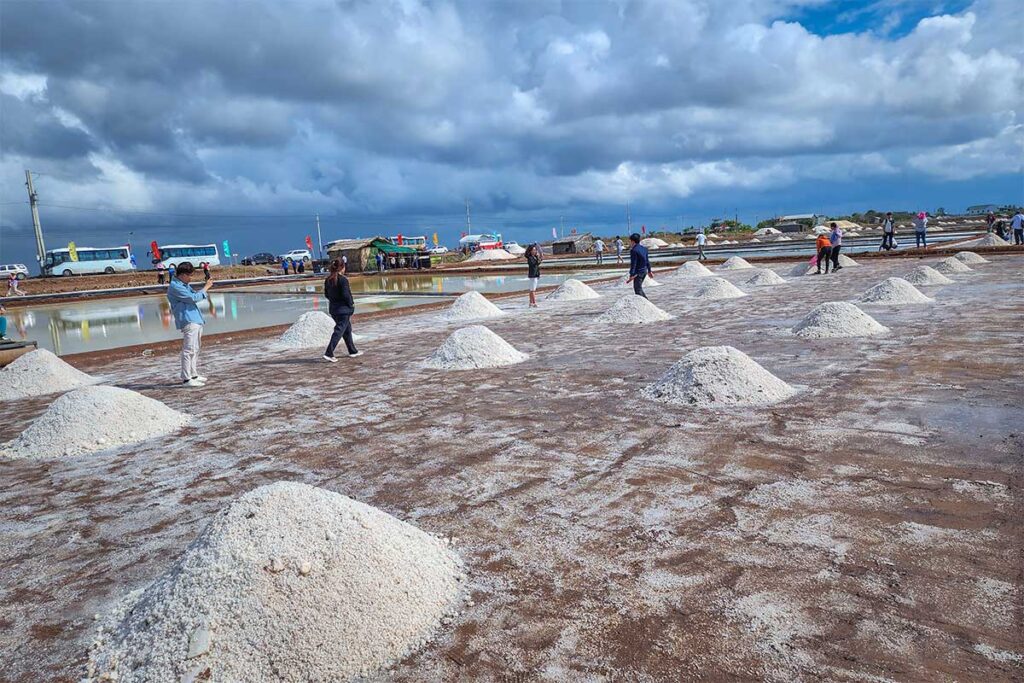What are the Bac Lieu Salt Fields?
History and Heritage
Salt making in Bac Lieu dates back to the early 20th century and quickly became the province’s defining livelihood. For decades, Bac Lieu was nicknamed “Salt Land,” and its products were known under names like Ba Thac salt or Long Dien salt—both once popular folk brands across southern Vietnam.
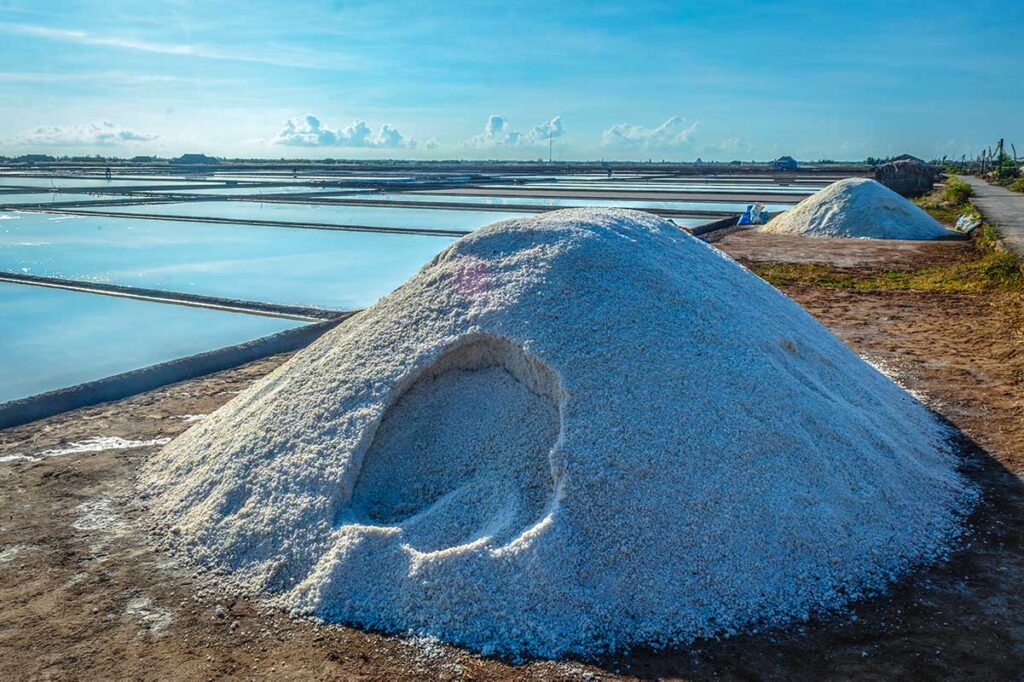
In 2013, Bac Lieu salt received protection for its geographical indication, and in 2020, the craft was officially recognized as a National Intangible Cultural Heritage. Despite ups and downs, the salt fields remain a symbol of both cultural identity and economic survival for many families.
The Salt Farmers’ Work
Salt making here is often a family profession passed down through generations, with some households counting six generations in the trade. The traditional method is simple but labor-intensive: preparing drying yards, letting seawater evaporate under the sun, and raking the remaining crystals into piles.

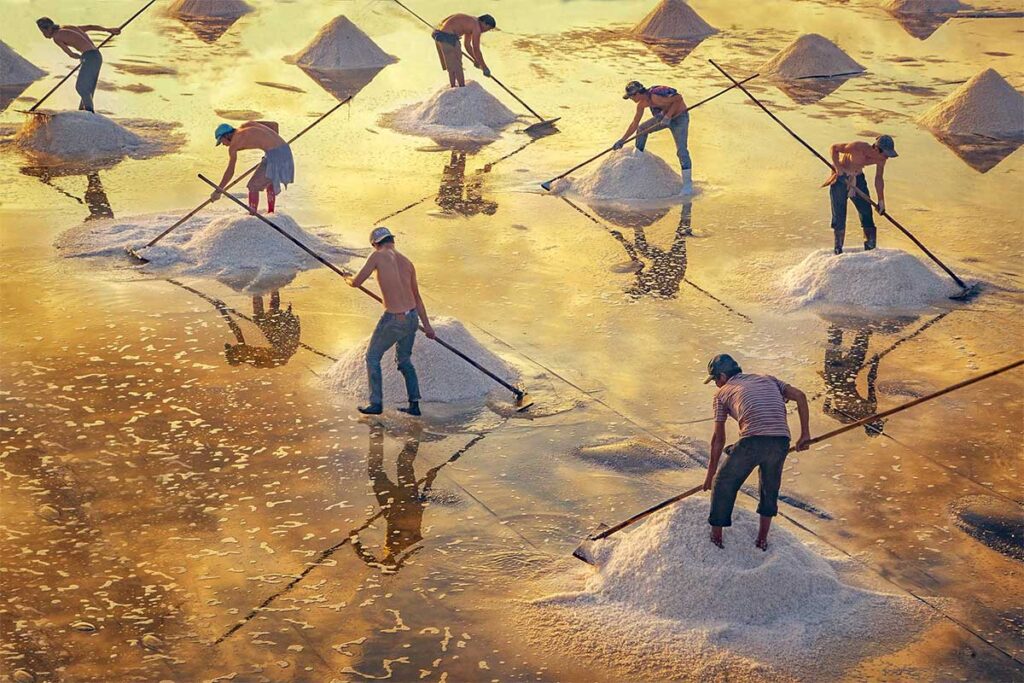
More recently, some farmers have started using plastic tarpaulins to improve quality and speed up production, though the investment is costly. The work is still heavily dependent on weather—too much rain can ruin weeks of effort—and falling salt prices have made it harder to sustain. As a result, the overall area of salt fields has been shrinking as some farmers switch to more profitable livelihoods.
The Landscape & Atmosphere
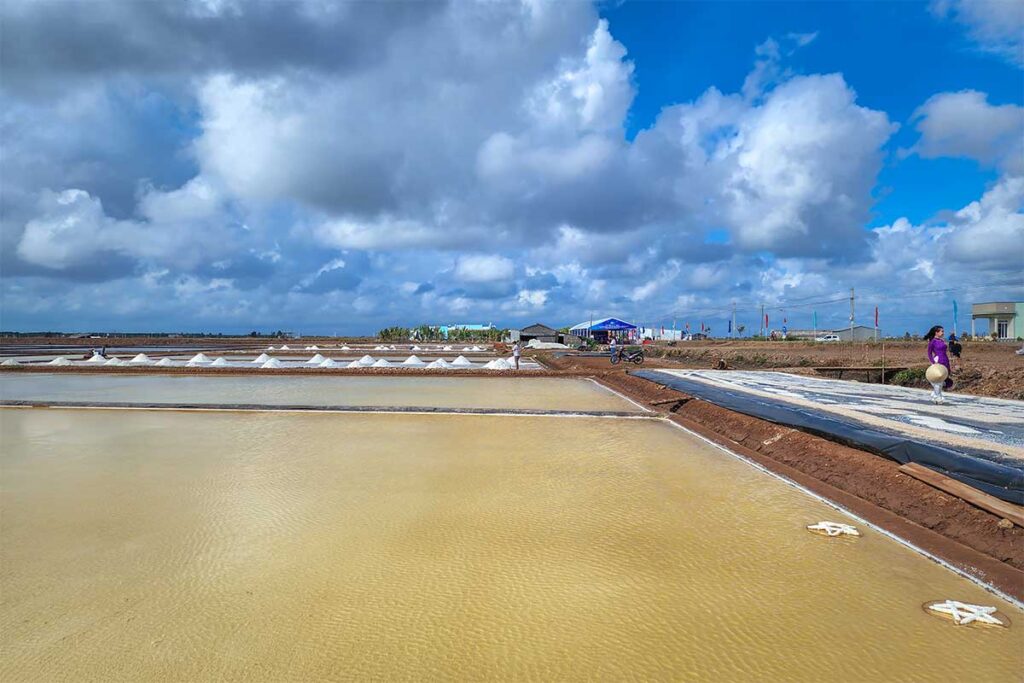
For visitors, the first impression is the wide, open landscape: flat salt fields stretching to the horizon, covered in white crystals that sparkle under the sun. At harvest, the salt is raked into neat piles that, from a distance, look like shimmering diamonds scattered across the fields. Farmers in conical hats pushing heavy carts add to the scene, making it a favorite for photographers. Still, behind the beauty is a tough reality—salt farming is exhausting, hot, and offers modest income at best. What you see here is not a polished tourist attraction but a genuine slice of rural Mekong Delta life.
Highlights of visiting the Bac Lieu Salt Fields
1. Scenic photography
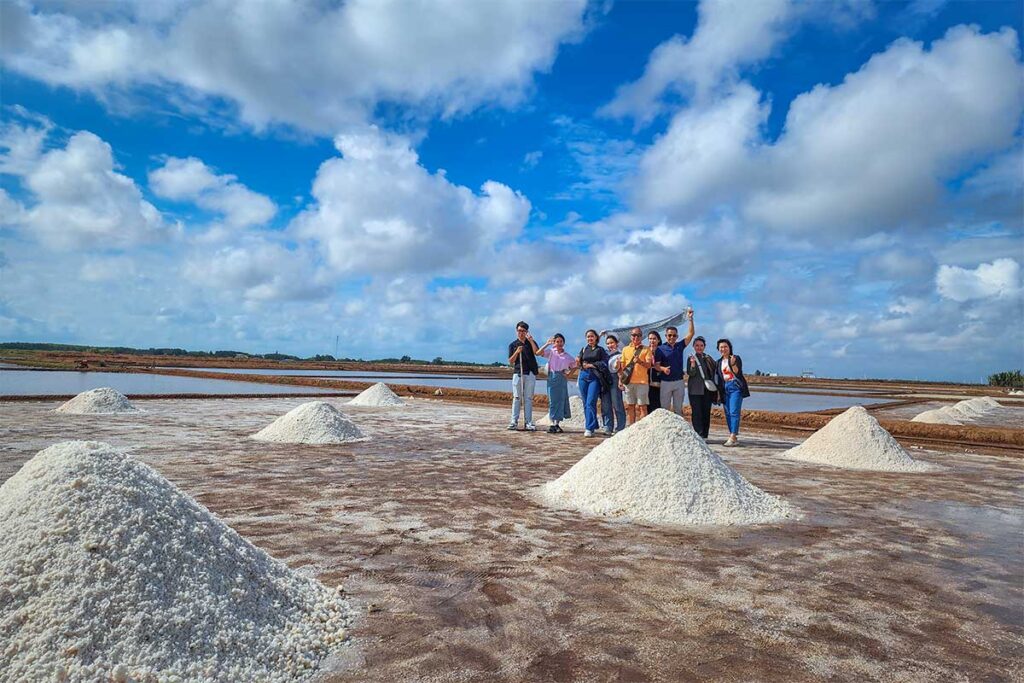
The salt fields are at their most striking in the early morning or late afternoon, when the light is soft and the white salt crystals shimmer. The contrast between the bright salt, deep blue sky, and workers in conical hats makes for classic Vietnam photos. At midday, the glare is strong and the heat can be uncomfortable, so most visitors avoid that time.
2. Witnessing salt harvesting
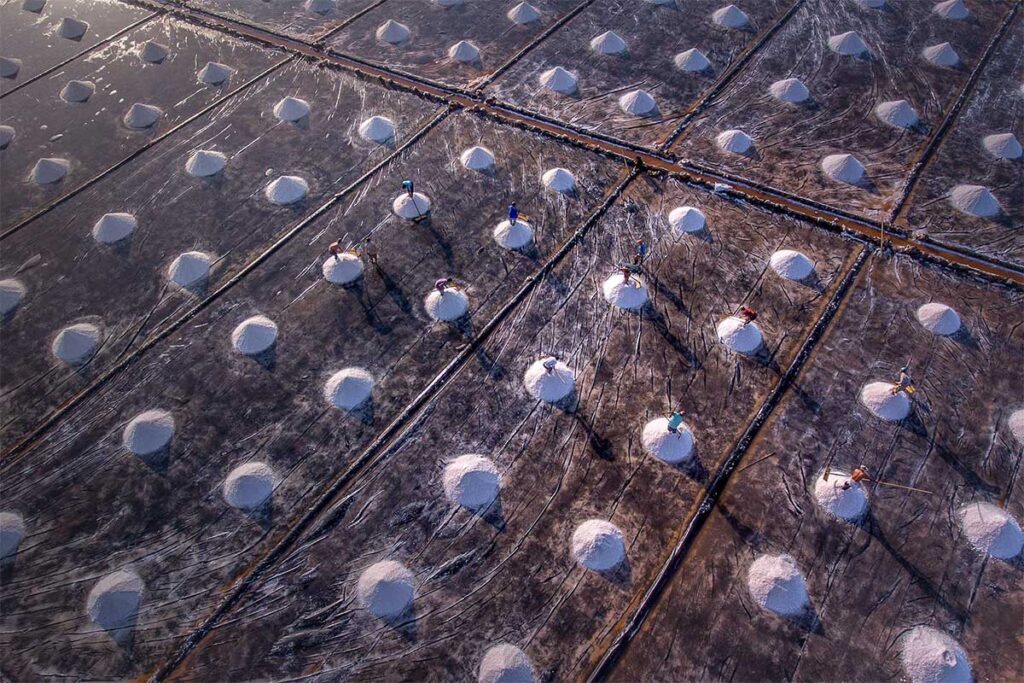
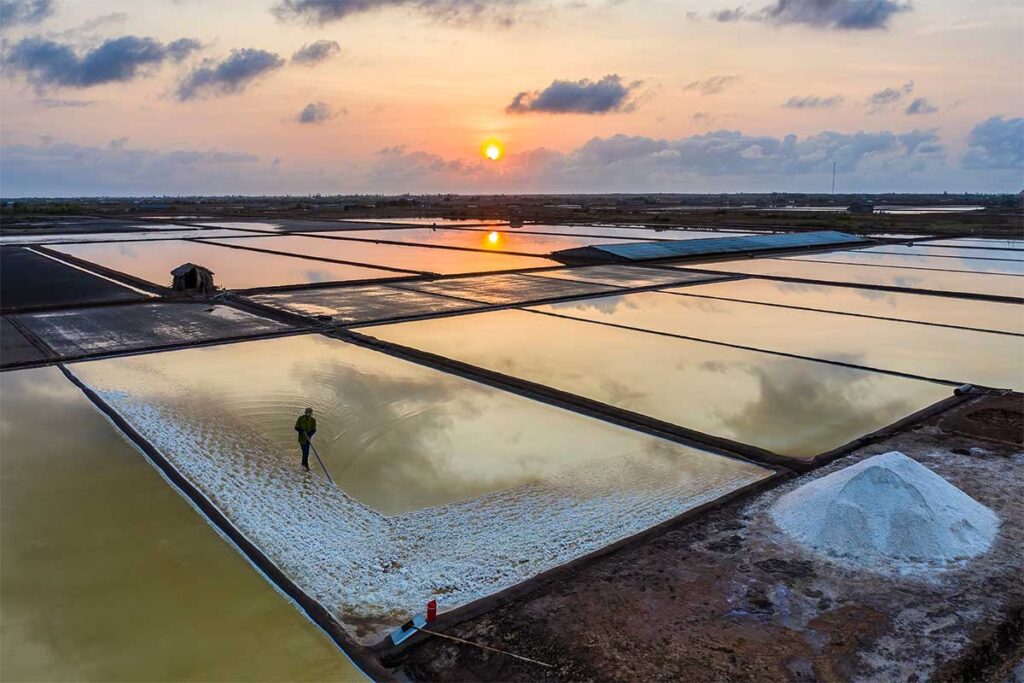
If you come during the harvest season (December–April), you’ll see farmers raking salt into neat rows and piling it into small white mounds. The work usually happens in the morning or late afternoon when it’s less hot. Watching this process gives a sense of how much effort goes into something as simple as table salt. Some farmers are open to letting you try raking for a photo, but it’s polite to ask first rather than just walking onto the fields.
3. Cultural encounter
Meeting the salt farmers is part of the experience. Many families have been in the trade for generations, and while most don’t speak English, a smile or gesture goes a long way. Unlike other parts of the Mekong Delta, this isn’t a staged or touristy stop—you’re stepping into a working environment. That makes the experience feel authentic, though also a bit limited if you’re hoping for detailed explanations or guided interaction.
4. Peaceful & off-the-beaten-Path experience
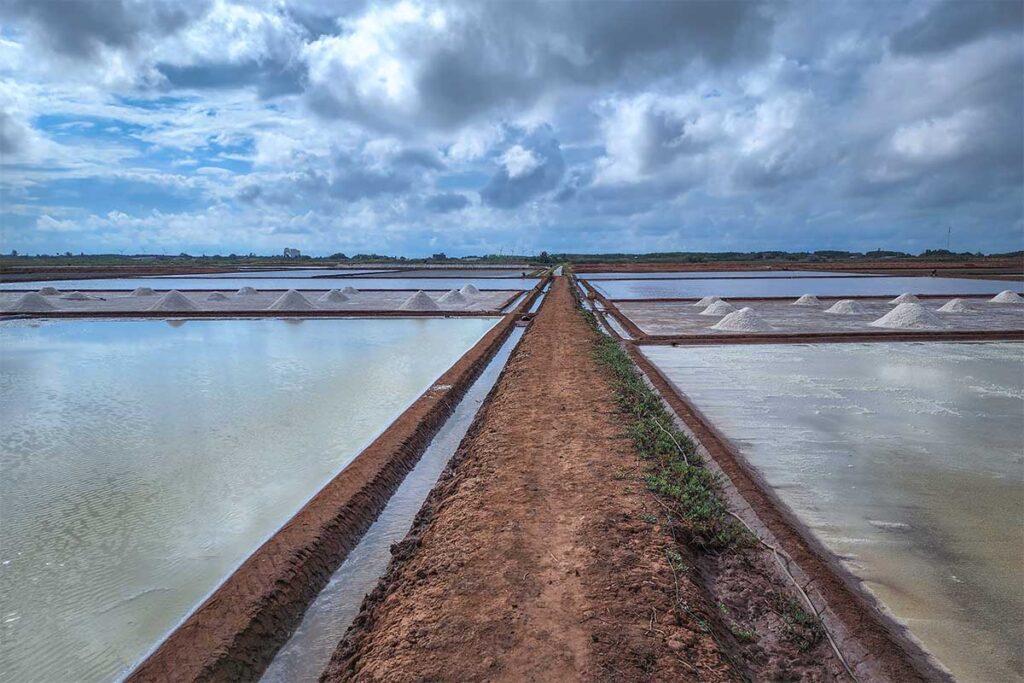
Compared to busy floating markets or city attractions, the salt fields offer a much quieter atmosphere. Standing among the rows of salt, with little more than the sound of rakes and carts, feels a world away from the usual tourist trail. It’s not an action-packed destination, but it can be rewarding if you appreciate slow travel and everyday rural life.
Best time to visit the Salt Fields
Salt Harvest Season
The salt harvest in Bac Lieu takes place during the dry season, from December to April. This is the only time of year when you can actually see farmers at work, raking salt into neat rows and piling it up. For photography and atmosphere, this period is by far the most rewarding. Outside of these months, the fields are quiet and may look like empty plots.
Time of day
The best hours to visit are early morning or late afternoon. Not only is the light softer—perfect for photos—but the temperature is also more comfortable. Farmers usually work during these times as well, so you’re more likely to see activity. At midday, the sun is strong, the glare on the salt can be blinding, and standing out in the fields quickly becomes uncomfortable.
Outside harvest season
If you visit outside the harvest season, the fields are still there but don’t offer the same visual impact. Without salt piles or workers, the landscape can look rather plain. You can still get a sense of the wide, coastal setting, but it’s more of a short stop than a highlight. If timing allows, it’s worth planning your visit for harvest months to make the most of the experience.
Practical visiting information
Location & Access
The main salt fields are located in Dong Hai and Hoa Binh districts, both along the coast of Bac Lieu Province. Depending on which area you visit, the distance from Bac Lieu City is between 12 km and 45 km. The landscapes are spread out, so don’t expect a single marked tourist site—it’s more a collection of fields across several communes.
How to get there
The salt fields can be reached by motorbike, taxi, or private car. The roads are generally paved and easy enough to drive, though once you leave the city the surroundings become more rural. There is no public bus service directly to the salt fields, so unless you’re comfortable riding a motorbike yourself, hiring a car or arranging a private transfer is the simplest option.
Visiting tips
- Protect yourself from the sun: bring a hat, sunglasses, sunscreen, and plenty of water.
- Wear sturdy shoes: the salt can be sharp underfoot and the ground is sometimes wet or uneven.
- Be respectful: this is a workplace, not a tourist attraction. Always ask before taking close-up photos of farmers or walking onto the drying yards.
- Timing matters: if you want to see the harvest, plan for morning or late afternoon in the dry season.
Nearby attractions
A trip to the salt fields is usually combined with other sights in Bac Lieu Province. Popular options include:
- Ghositaram Pagoda – one of the most impressive Khmer temples in Vietnam.
- Xiem Can Pagoda – a large, colorful Khmer-style complex near the coast.
- Tac Say Church – famous as the pilgrimage site of Father Diep.
- Bac Lieu Bird Sanctuary – wetlands with storks and herons, best in the morning.
- Bac Lieu Wind Farm – rows of wind turbines out at sea, a striking modern contrast to the salt fields.
Together, these stops make a full day trip more worthwhile.
Are the Bac Lieu Salt Fields worth visiting?
The Bac Lieu Salt Fields are certainly worth a look if you’re already traveling in the area. They offer a mix of cultural heritage, authentic rural life, and scenic views that can be especially rewarding for photographers. Seeing farmers at work during harvest season adds an extra layer of interest, and the vast white fields shimmering in the sun are quite striking.
That said, expectations should be kept realistic. There isn’t much infrastructure for visitors, and outside the December–April harvest season the fields can feel empty and repetitive. Even in peak season, this is usually a short stop of one to two hours, not a full-day destination on its own.
In short: the salt fields make a good addition to an itinerary if you’re already exploring Bac Lieu or Ca Mau. But they’re not worth a long detour from Ho Chi Minh City just to see them.
